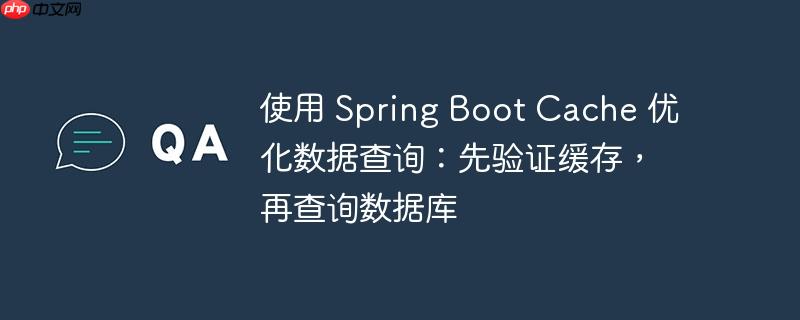
本文旨在探讨如何利用 Spring Boot Cache 实现更高效的数据查询,特别是针对先验证缓存中是否存在所需数据,若缺失再从数据库中获取的场景。我们将深入分析 Spring Cache 的工作原理,并提供一种实现方案,帮助开发者在保证数据一致性的前提下,提升应用程序的性能。
Spring Cache 提供了一种声明式的缓存机制,通过注解简化了缓存的使用。然而,对于“先查缓存,缺失再查数据库”的需求,Spring Cache 默认的行为存在一些局限性。
假设我们有一个 Student 实体,需要根据 ID 集合查询学生信息,并进行缓存。
@Cacheable("students")
List<Student> findByIds(Set<Integer> ids) {
// 从数据库查询
return studentRepository.findByIdIn(ids);
}这段代码看似简单,但存在以下问题:
为了解决上述问题,我们需要自定义缓存逻辑,手动控制缓存的读取和写入。以下是一种可行的方案:
import org.springframework.cache.Cache;
import org.springframework.cache.CacheManager;
import org.springframework.stereotype.Service;
import java.util.*;
import java.util.stream.Collectors;
@Service
public class StudentService {
private final StudentRepository studentRepository;
private final CacheManager cacheManager;
public StudentService(StudentRepository studentRepository, CacheManager cacheManager) {
this.studentRepository = studentRepository;
this.cacheManager = cacheManager;
}
public List<Student> findByIdsWithCache(Set<Integer> ids) {
Cache cache = cacheManager.getCache("students");
List<Student> result = new ArrayList<>();
Set<Integer> idsToQuery = new HashSet<>(ids);
// 1. 从缓存中获取数据
for (Integer id : ids) {
Cache.ValueWrapper wrapper = cache.get(id);
if (wrapper != null) {
Student student = (Student) wrapper.get();
result.add(student);
idsToQuery.remove(id); // 从待查询 ID 集合中移除已缓存的 ID
}
}
// 2. 查询数据库
if (!idsToQuery.isEmpty()) {
List<Student> dbResults = studentRepository.findByIdIn(idsToQuery);
result.addAll(dbResults);
// 3. 将数据库查询结果写入缓存
for (Student student : dbResults) {
cache.put(student.getId(), student);
}
}
return result;
}
}代码解释:
注意事项:
Spring Cache 是一个强大的缓存工具,可以帮助我们提升应用程序的性能。然而,对于一些复杂的缓存需求,我们需要自定义缓存逻辑,手动控制缓存的读取和写入。通过合理地选择缓存 Key、避免缓存穿透和雪崩、保证缓存一致性,我们可以充分利用 Spring Cache 的优势,构建高性能的应用程序。
以上就是使用 Spring Boot Cache 优化数据查询:先验证缓存,再查询数据库的详细内容,更多请关注php中文网其它相关文章!

每个人都需要一台速度更快、更稳定的 PC。随着时间的推移,垃圾文件、旧注册表数据和不必要的后台进程会占用资源并降低性能。幸运的是,许多工具可以让 Windows 保持平稳运行。

Copyright 2014-2025 https://www.php.cn/ All Rights Reserved | php.cn | 湘ICP备2023035733号